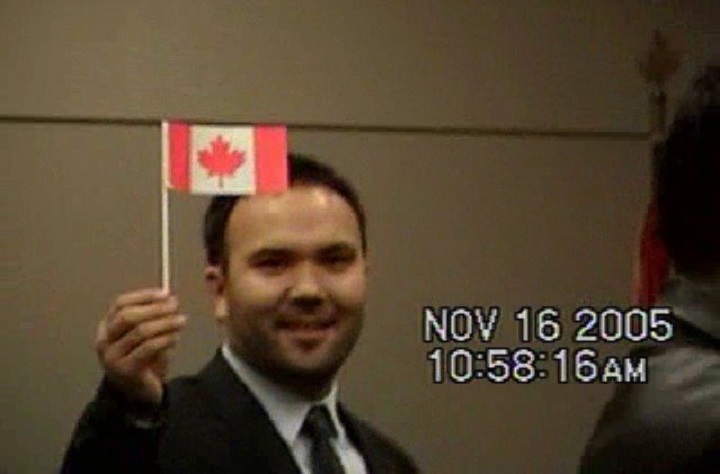
By
Jeff Semple
Global News
Published June 24, 2021
9 min read

Bin Zhang was sitting in the departure lounge of Vancouver International Airport on Jan. 22, 2020, waiting to board his flight to Beijing, when a breaking news bulletin flashed across a television screen.
The Chinese government was preparing to lock down the city of Wuhan in an effort to contain the spread of a mysterious new virus.
Zhang lives in Calgary, but grew up in Wuhan. He was on his way there to meet his wife and two young children, who had travelled ahead of him to celebrate Chinese New Year.
“The most intense thing I’ve ever done is calling and waking up my family in the middle of the night to tell them to escape the city,” Zhang recalled.
On Episode 4 of China Rising, we visit the front lines of the first COVID-19 outbreak in Wuhan, China, and investigate how Beijing is now capitalizing on the worst health crisis in modern history.
Three weeks earlier, on New Year’s Eve in 2019, health officials in Wuhan published a news release on their municipal government website warning about a cluster of pneumonia cases linked to a local seafood market.
Within days, Zhang’s family in Wuhan started hearing rumours that this virus was different.
“We first heard it in the beginning of January, through friends, some relatives that work at the hospitals,” Zhang told Global News.
“We started to hear about these rumours about a SARS-like virus spreading in the city. Certainly, we had no idea to what extent this thing was going to grow into.”
For three weeks, Chinese health officials claimed the virus was only transmitted through contact with infected animals. But on Jan. 20, Beijing revealed the truth: They were dealing with a mysterious new coronavirus that was spreading between people.
The Chinese government responded by cutting off the entire city and its 11 million residents from the rest of the world, as they scrambled to contain the spread of an unidentified illness temporarily named “2019-nCoV”.
As he boarded his flight from Vancouver to Beijing, Zhang phoned his family in Wuhan and told them to leave the city.
“Once I landed in Beijing, I went to the (airport) front desk,” he recalled. “And I said, ‘I’m flying to Wuhan.’ And they said, ‘No, you’re not. The whole city is shut down. Nothing is flying in or out.'”
So Bin caught a flight to a city nearby and drove the rest of the way, eventually reuniting with his family.
He said Wuhan was unrecognizable.
“It was scary, to be honest with you. I have never seen the city like that. To call it a ‘ghost town’ is not an exaggeration. I mean, there were no vehicles on the road,” he said.
“There were no people in the street. Everything was closed except the hospitals. It was eerie.”
After a couple of weeks, the Canadian government sent a plane to rescue Canadians trapped in Wuhan, including Zhang and his family. Within weeks, COVID-19 was everywhere.
On March 11, 2020, the World Health Organization officially declared a pandemic, citing more than 120,000 known cases in 114 countries.
But by the end of April 2020, while Western countries were reeling, the city of Wuhan declared itself COVID-free.
“Everything was back to normal,” said Wuhan resident Hong Xu, a professional pianist who has performed all over the world, including in Canada.

He was travelling in the United States when Wuhan was locked down in January 2020. Xu finally returned home a couple of days after the lockdown ended.
“When I went back to Wuhan, there was still not many people on the streets,” Xu recalled. “And then it was like two weeks later, it was back to normal. Everybody was out. And yeah, it was just very exciting.”
While many question the reliability of the Chinese government’s official case counts and death toll from COVID-19, China’s success at stamping out the pandemic is difficult to deny.
By the summer of 2020, Wuhan was roaring back to life, with crowds packing into concert halls, food markets, offices and schools.
“I actually really do the credit the Communist Party on controlling the pandemic. I think whatever they have done since I guess February (2020) has been just very effective,” Xu said.
Xu says anyone who went anywhere was required to scan an ID code on their smartphone, which the government used to track potential cases.
“We all have this code on our cellphones and it monitors everybody. Basically, you have no privacy but it works very well for this pandemic,” he explained. “That code is monitored by the government. And let’s say if someone got COVID, they will detect everybody who was around that area for a certain period of time.
“We all have a green code, but if your code turns yellow then you’re banned from going anywhere, basically.”
Any time there was even a small outbreak of COVID-19, Chinese authorities cracked down with a heavy hand.
Videos on social media showed people who’d been potentially exposed or had a fever being dragged by police, kicking and screaming, out of their homes and into quarantine centres — massive stadiums and exhibition halls that were rapidly repurposed.
Ahead of the one-year anniversary of the Wuhan outbreak, the Chinese government declared victory over the pandemic, unveiling a new sprawling exhibition built on the site of a former field hospital in Wuhan. It recounted the government’s purported triumph over the pandemic; the walls were lined with photographs of medical workers, alongside an imposing image of Chinese President Xi Jinping.
There were recreated scenes with mannequins dressed as doctors in biohazard suits, and even a futuristic hologram of medical staff in a hospital room.
One visitor told Global News that she lived five hours away on a train, but that she came to Wuhan especially for the exhibition.
“I’m really touched,” she said. “I feel that our country is really awesome.”
“Our government does a good job,” another woman said. “People in China are conscious that we must work together, and that the good of the people is more important than any one individual. However, in the West, people often put priorities on their own opinions. I think that’s why the pandemic is out of control in the West.”
But the impressive Wuhan exhibition was also remarkable for what was missing.
There is no mention of Wuhan’s whistleblowers; of how doctors, like Li Wenliang, first sounded the alarm by publicly warning that the virus was spreading between people in December 2019, a month before the city was locked down.
The exhibition also makes no mention of citizen journalists, such as like Zhang Zhan; She recorded videos inside Wuhan’s hospitals, revealing the true scale of the outbreak. One year later, in December 2020, Zhang was sentenced to four years in prison for ‘picking quarrels and provoking trouble.’
And there’s another part of the Western pandemic narrative that the Chinese government seems particularly interested in challenging: COVID-19’s origin story.
Chinese state media has been busy promoting a number of different theories
Chinese officials have claimed without evidence, for example, that COVID-19 is an American disease that was introduced by members of the United States Army who visited Wuhan in October of 2019.
Chinese state media has also claimed the virus originated in Europe and arrived in Wuhan on a shipment of frozen seafood.
“The idea that this was frozen seafood imported to China from elsewhere from Europe is pretty unlikely, considering the closest relatives to SARS coronavirus are circulating in the wild in bats in East Asia,” explained University of Saskatchewan virologist Angela Rasmussen.
“We can’t disprove that hypothesis, it’s not off the table; But I just think that is by far the most unlikely hypothesis.”
While scientists and politicians argue about the origins of the pandemic, Chinese businesses are busy capitalizing on the chaos.
China was the only major economy that actually grew last year — thanks, in part, to the sudden, unprecedented demand for Personal Protective Equipment.
Even before the pandemic, China supplied most of the world’s PPE, but last year those exports skyrocketed. Around 95 per cent of Canada’s imported face masks came from China, costing $1.5 billion.
These days, China’s most popular pandemic export is its COVID-19 vaccinations. Chinese vaccines have been shipped to more than 80 countries, including a large number of developing nations in Eastern Europe and Latin America.
After some Chinese vaccines faced criticism for their lower efficacy, Chinese state media responded with criticism of its own; promoting disinformation aimed at undermining trust in Western vaccines, such as Pfizer-BioNtech.
“We’re looking at the Internet where China is basically saying that Canada’s response to COVID shows that the Chinese model is better, democracy doesn’t work, and also questioning any of the vaccines that have been approved in Canada,” said Kyle Matthews from the Canadian Coalition to Counter COVID Digital Information.
Matthews says Beijing is using the COVID chaos in Western democracies as a propaganda opportunity, pushing the narrative that the pandemic has proved the superiority of its authoritarian model.
Its government is capable of cracking down on even small outbreaks with tremendous force, while suppressing any criticisms and disregarding any notion of individual freedoms.
Beijing’s relative success in curtailing the health crisis is garnering plenty of praise from ordinary Chinese.
Bin Zhang, the Calgary father from Wuhan, said that last year, as Canada’s COVID-19 caseload climbed, he considered taking his family out of Calgary and back to Wuhan.
“We did contemplate maybe flying back that way because, you know, we’d be safer for our kids, safer for us. But on the other hand, you know, Calgary is where our home is.”
Bin said his friends and family in Wuhan didn’t just abide by the 76-day lockdown because they had to, but also because they believed in it.
“I personally believe that it’s because of the high level of personal engagement that got China to where they are right now, because everybody buys into the idea. They never had any anti-mask protests.
“Everybody buys into the idea of personal hygiene, social distancing, masking. And so they were able to eliminate the virus in a very short period of time. I think just the way they did it is pretty, pretty amazing.”
To subscribe and listen to this and other episodes of China Rising for free, click here.
















Comments